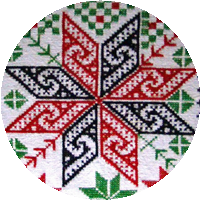Musical Instruments
Please click any thumbnail at right for a larger image!
Click any highlighted name to hear its pronunciation!
Ancient Mexico created a variety of wind and percussion instruments, many of which remain in use among today's indigenous descendants. Although we have only a few clues as to what melodies the old musicians followed, we can at least appreciate their distinct designs and sounds.
One of the most iconic of Mesoamerica's native instruments is the teponaztli, a hollowed trunk with two slats of different lengths to generate tones. At left is a spectacularly carved example from the Mixtec of Oaxaca. It is ornamented with fret and whorl designs. The ceramic vase on the right is painted with the image of a kneeling Mixtec musician, playing passionately upon the instrument with a pair of mallets.
Regional Museum of the Cultures of Oaxaca
The Nahuatl language of the Aztecs had verbs for playing different musical instruments, some of which were derived from the name of the instrument itself. To play the teponaztli was teponazoa, for example; and in the modern Huasteca dialect in Veracruz, the verb tlatzotzona is a general term for playing music.
These two wooden teponaztlis are exceptional examples of the smooth, controlled relief sculpture that could accompany their sound. The instrument at left is stylized into an animal's head, with a prominent snout. The one at right is shaped like a prone human figure. It comes from the southern state of Guerrero.
National Museum of Anthropology and History
The other major wooden percussion instrument was the drum, played upon a surface of deerhide stretched across the end. The standing form is known popularly as huehuetl, such as the magnificently carved example at left from the southern Aztec region of Malinalco. Upon its length two eagles issue songs from their mouths, fluid like water (left) and aesthetic like blossoms (right). The miniature ceramic at right comes from Nayarit in West Mexico, and it depicts a drummer sitting upon a long drum as he strikes it with both hands.
National Museum of Anthropology and History
Named after a community toward the southern end of Guanajuato State, Chupícuaro was an important culture region during the Late Formative Period (400 BC – 150 AD) in Central Mexico. While it was unusual during its time because of how little influence it received from their Olmec contemporaries, they did share culture elements with the rest of Mesoamerica, most prominently their polished ceramic traditions. Their high-quality ceramics included many musical instruments such as the trio of flutes and bird-shaped maracas presented here.
National Museum of Anthropology and History
Used notably for religious ceremonies, the conch trumpet was bleated with powerful, haunting resonance. Its spiral hollow came to symbolize the lunar cycle, the circulation of breath, or the energy of life under different ritual contexts. As such, it had profound mystical connotations that were carried through its imposing tenor. This decorated conch comes from Teotihuacan. The ceramic figure at right is a trumpeter from Nayarit in West Mexico.
National Museum of Anthropology and History
Musical instruments came from many available materials, including this example in bone from Oaxaca. In Aztec ritual flutes had special connection with Tezcatlipoca, god of power and destiny. One of the sacrifices prepared for him would actually be painted in his black and dressed in his attire, and he would play a flute as he climbed the temple stairs to the altar. One of the metaphors for representing the god's presence on earth was to be likened to a "flute" of Tezcatlipoca. The Nahuatl word for 'flute' was tlapitzalli, derived from the verb pitza, 'to play a wind instrument.'
National Museum of Anthropology and History
Chicahuaztli comes from the Nahuatl chicahua, meaning 'strong' or 'loud' - similar to fuerte in Spanish. This term could be used for either the rattle-staff (like a "rain stick") or the rasp, such as those featured below.
From the Aztec civilization, these golden sheets are etched into miniature rattle-staffs, identifiable by the long, barbed arrows pointing to the left. Ideally, the arrows would be pointing upward as the musician shook the staff. It was an instrument associated with especially Xipeh Toteuc, god of sacrifice and the spring.
National Museum of Anthropology and History
Rasps were also common instruments, and bone was the foremost material for their crafting. The musician would rub a wooden or bone staff against the deep grooves cut against the bone's shaft. The rasp at left still has its socket, which helps identify it as coming from an animal's tibia or thigh bone. The rasp on the right is unique in Mesoamerica because it is the only ancient artifact known to be made from a whale bone, in this case a rib! It has four sets of grooves along its inner arc, perhaps to allow up to four musicians to play on it at once!
National Museum of Anthropology and History
Made in various shapes, materials, and sizes, rattles were closely related to ritual dance. The two small rattles to the right in this photo have stirruped handles, suggesting that they would have hung from a fixture or even an article of clothing during a dance. From the ancient world to the modern day, dancers wore bells and rattles around their limbs, their vigorous pacing generating musical sound. In recent years I have seen Aztecs hold rattles in their dances, such as when they pray for rain or health.
National Museum of Anthropology and History


















